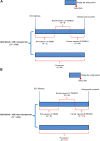Timing, Dosage, and Adherence of Antiretroviral Therapy and Risk of Osteoporosis in Patients With Human Immunodeficiency Virus Infection in Taiwan: A Nested Case-Control Study
- PMID: 33995032
- PMCID: PMC8121495
- DOI: 10.3389/fphar.2021.631480
Timing, Dosage, and Adherence of Antiretroviral Therapy and Risk of Osteoporosis in Patients With Human Immunodeficiency Virus Infection in Taiwan: A Nested Case-Control Study
Abstract
The progression of acquired immunodeficiency syndrome is delayed in patients with human immunodeficiency virus (HIV) infection receiving antiretroviral therapy (ART). However, long-term ART is associated with adverse effects. Osteoporosis is one of the adverse effects and is a multifactorial systemic skeletal disease associated with bone fragility and an increased risk of fracture. We performed a longitudinal, comprehensive, nested case-control study to explore the effect of ART on the risk of osteoporosis in 104 osteoporotic and 416 non-osteoporotic patients with HIV infection at their average age about 29 years old in Taiwan. Patients with history of ART, current exposure to ART, higher cumulative defined daily doses (DDDs), or higher ART adherence were at a higher risk of osteoporosis (p < 0.05). Patients receiving nucleoside/nucleotide reverse transcriptase inhibitor (NRTI)-containing regimen (zidovudine-lamivudine combination, lamivudine-abacavir combination, and abacavir alone) and protease inhibitor (PI)-containing regimen (lopinavir-ritonavir combination, ritonavir, and atazanavir) had a higher risk of osteoporosis (p < 0.05). Especially, patients receiving high doses of the PIs lopinavir-ritonavir combination had an increased risk of osteoporosis (p < 0.05). In conclusion, history of ART, current exposure to ART, higher cumulative DDDs, and higher ART adherence were associated with an increased risk of osteoporosis. Furthermore, NRTI- and PI-containing regimens and high doses of PIs lopinavir-ritonavir combination may be associated with an increased risk of osteoporosis in patients with HIV infection in Taiwan.
Keywords: HIV; adherence; antiretroviral therapy; dosage; osteoporosis; usage timing.
Copyright © 2021 Chiu, Liang, Li, Cheng, Chiou, Ho, Wu, Lin, Liao, Huang, Tsai and Lin.
Conflict of interest statement
The authors declare that the research was conducted in the absence of any commercial or financial relationships that could be construed as a potential conflict of interest.
Figures




Similar articles
-
Effect of antiretroviral therapy use and adherence on the risk of hyperlipidemia among HIV-infected patients, in the highly active antiretroviral therapy era.Oncotarget. 2017 Nov 15;8(63):106369-106381. doi: 10.18632/oncotarget.22465. eCollection 2017 Dec 5. Oncotarget. 2017. PMID: 29290955 Free PMC article.
-
Antiretroviral Therapy in the Real World : Population-Based Pharmacoeconomic Analysis of Administration of Anti-HIV Regimens to 990 Patients.Clin Drug Investig. 2005;25(8):527-35. doi: 10.2165/00044011-200525080-00005. Clin Drug Investig. 2005. PMID: 17532696
-
Switching to lopinavir/ritonavir with or without abacavir/lamivudine in lipoatrophic patients treated with zidovudine/abacavir/lamivudine.J Antimicrob Chemother. 2013 Jun;68(6):1373-81. doi: 10.1093/jac/dks540. Epub 2013 Feb 5. J Antimicrob Chemother. 2013. PMID: 23386261 Clinical Trial.
-
Combination of protease inhibitors for the treatment of HIV-1-infected patients: a review of pharmacokinetics and clinical experience.Antivir Ther. 2001 Dec;6(4):201-29. Antivir Ther. 2001. PMID: 11878403 Review.
-
[Lopinavir/ritonavir in new initial antiretroviral treatment strategies].Enferm Infecc Microbiol Clin. 2014 Nov;32 Suppl 3:7-11. doi: 10.1016/S0213-005X(14)70161-2. Enferm Infecc Microbiol Clin. 2014. PMID: 25542869 Review. Spanish.
Cited by
-
Chronic kidney disease among HIV-positive Zambian adults with tenofovir-associated nephrotoxicity at University Teaching Hospital (UTH) in Lusaka.PLoS One. 2025 Aug 14;20(8):e0330356. doi: 10.1371/journal.pone.0330356. eCollection 2025. PLoS One. 2025. PMID: 40811628 Free PMC article.
-
Association of combination antiretroviral therapy with risk of neurological diseases in patients with HIV/AIDS in Taiwan: a nested case-control study.Front Pharmacol. 2023 Jun 8;14:1110605. doi: 10.3389/fphar.2023.1110605. eCollection 2023. Front Pharmacol. 2023. PMID: 37361207 Free PMC article.
-
Prevalence and associated factors of low bone mineral density in people living with HIV: a cross-sectional study.Arch Osteoporos. 2024 Jul 2;19(1):56. doi: 10.1007/s11657-024-01413-3. Arch Osteoporos. 2024. PMID: 38954143
-
Lopinavir-menthol co-crystals for enhanced dissolution rate and intestinal absorption.J Drug Deliv Sci Technol. 2022 Aug;74:103587. doi: 10.1016/j.jddst.2022.103587. Epub 2022 Jul 11. J Drug Deliv Sci Technol. 2022. PMID: 35845293 Free PMC article.
-
Effect of Chinese herbal medicine therapy on risks of all-cause mortality, infections, parasites, and circulatory-related mortality in HIV/AIDS patients with neurological diseases.Front Pharmacol. 2023 Mar 3;14:1097862. doi: 10.3389/fphar.2023.1097862. eCollection 2023. Front Pharmacol. 2023. PMID: 36937878 Free PMC article.
References
-
- Aberg J. A., Gallant J. E., Ghanem K. G., Emmanuel P., Zingman B. S., Horberg M. A., et al. (2014). Executive Summary: Primary Care Guidelines for the Management of Persons Infected With HIV: 2013 Update by the HIV Medicine Association of the Infectious Diseases Society of America. Clin. Infect. Dis. 58, 1–10. 10.1093/cid/cit757 - DOI - PubMed
-
- Ciccullo A., D'avino A., Lassandro A. P., Baldin G., Borghetti A., Dusina A., et al. (2018). Changes in Bone Mineral Density in HIV-Positive, Virologically Suppressed Patients Switching to Lamivudine/dolutegravir Dual Therapy: Preliminary Results from Clinical Practice. Infez Med. 26, 336–340. - PubMed
LinkOut - more resources
Full Text Sources
Other Literature Sources
Research Materials
Miscellaneous

